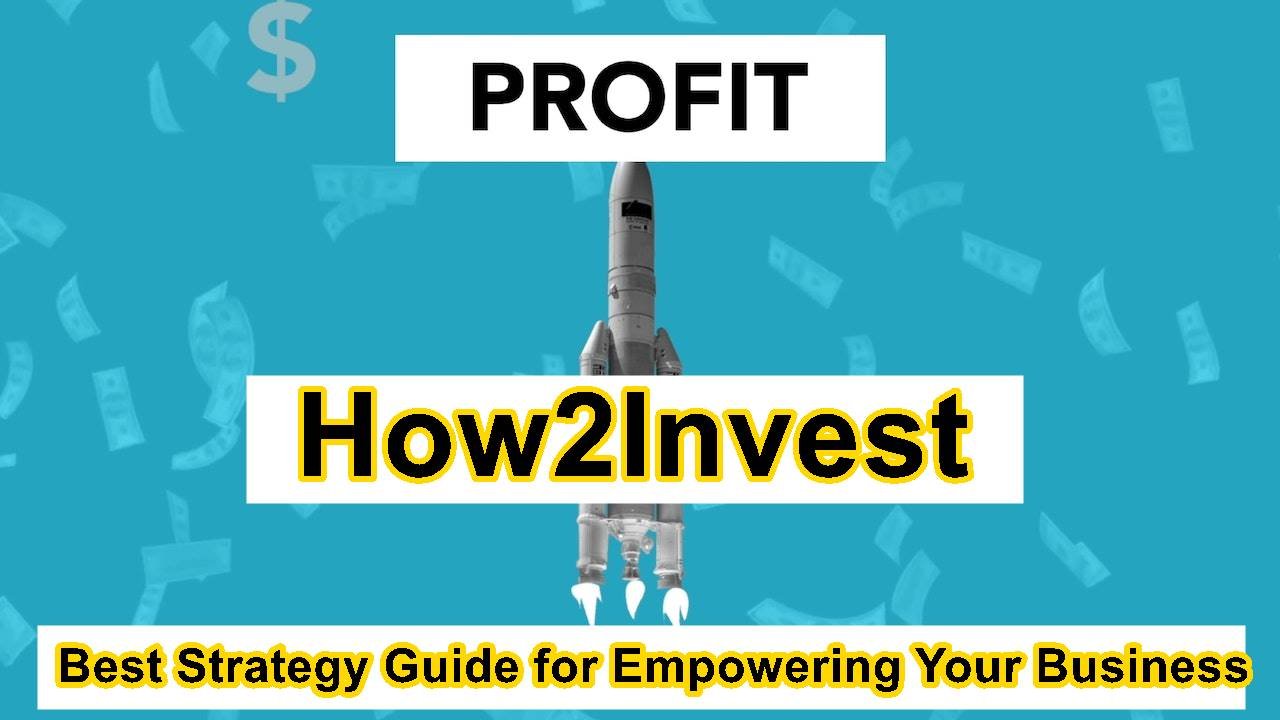The market can be intimidating. However, it doesn’t need to be. Did you know that various tools such as “How2Invest” exist to simplify the confusing investment world for novices and experts?
Our extensive blog will walk you through the essential strategies, laws, and various types of investments that How2Invest covers, making managing money a straightforward approach.
Intrigued? Find out more about a profitable journey to follow.
Content Highlights
- How2Invest is an extensive guide to investing that is designed to make investing more accessible for both novices and experienced investors alike, offering valuable advice as well as step-by-step guidance for investing wisely.
- Understanding the market cycle is crucial to investing successfully since it helps investors make better decisions on buying or selling their investments based on regular trends of declining and growing across different financial markets.
- The most effective strategies for investing are broadening your investment portfolios, implementing dollar-cost averaging, taking a long-term approach to investing and looking into the value of investing. Strategies like these can assist you in achieving goals in financial planning and reducing risk.
What is How2Invest?

How2Invest is a complete investment guide that provides investors with helpful details and step-by-step directions for investing their funds smartly.
Aim of How2Invest
The primary goal of How2Invest is to provide an extensive resource to help you understand the various investment and financial products available as well as strategies. By providing impartial information, This platform is focused on improving the financial literacy of novice and experienced investors.
From the basic principles of value investing to identifying undervalued assets, How2Invest provides investors with crucial knowledge to make intelligent decisions. Additionally, they focus on helping investors build diversified portfolios that minimize risk while increasing potential return.
Necessity of How2Invest
Knowing the basics makes investing complex, so How2Invest illustrates its importance. It’s an extensive platform that provides investors with essential information and the tools to make their own investment choices confidently.
There is no need to navigate complex financial terminology or procedures since How2Invest simplifies the whole process. It offers step-by-step guides to aid novices in navigating the tricky terrain of investing.
The site shines by providing crucial information to help you make smart investments and a feature that further accentuates its importance. From information on the individual stock market ETFs, stocks and Mutual fund information to understanding how lucrative IPOs perform on the market for shares, How2Invest got you covered.
A professional guide to real estate investment and the beginning of your business can further strengthen its importance in the investment journey. Through How2Invest, you can accelerate their progress toward achieving their financial goals and reduce the risk related to investment decisions.
Goal of How2Invest
The principal purpose of How2Invest is to provide potential investors with the necessary knowledge of various investment options, including bonds and stocks, to real property property. By offering impartial, up-to-date financial data instead of promoting specific products on the market, this platform How2Invest allows users to make educated choices about their investment decisions.
How2Invest is a website that helps individuals recognize undervalued securities, spot lucrative Initial Public Offerings (IPOs), understand the cycles of markets, and devise successful strategies for investing.
The company’s commitment to educating its members about potential income-generating opportunities demonstrates a profound commitment to individual wealth creation and financial freedom through intelligent investment choices. In addition, you could look up the top ways to invest PS100k in 2023.
Understanding Market Cycles

Understanding the cycle of market activity is vital for anyone who wants to navigate the financial markets effectively. Market cycles refer to patterns of increase and decrease in various financial markets, including real estate, stocks and options.
By looking at these cycles and understanding their various phases, investors can make educated choices on when to invest the investment or sell it.
Market cycles generally comprise four phases
Growth, decline, bull market and bear market. In the growth phase, price increases in a steady manner as demand grows. This stage is typically associated with optimism and high confidence among investors.
It is also crucial to remember that there is no way to guarantee that an upward movement can last forever.
The decline phase is followed by the phase of growth, where prices begin to decrease due to a decline in demand or other factors. This time can challenge investors as fears and a sense of dread set in.
It’s important not to be panicked at this point, but instead, keep relaxed and focused on your long-term goals for investment.
The bull market is a period of steady price increases across various asset classes. They are generally associated with economic growth. The excessive vitality of a person is typical of such times.
Contrarily, bear markets are when asset prices continue to drop over time, accompanied by widespread pessimism, which results in significant losses to investors.
Understanding the market cycle’s natural cycles of ebb flows in terms of intellectual understanding, and an awareness of how one responds during each cycle allows investors to make better investments.
The lessons learned from previous cycle
Behavior gives valuable insight into the future trends that allow for accurate forecasts within reasonable limits.
Being conscious of the patterns can help you recognize possible opportunities in market volatility when other traders may be selling at lower prices.
Be aware that although knowing the market cycle is crucial, it’s not enough to guarantee the success of investing. It is where understanding, timing, and risk management expertise come into play. Knowing the intricacies of risk management allows informed decision-making. Always seek professional advice when implementing your strategy based on the market’s cyclicality. A knowledgeable investment advisor can help you navigate the peaks and valleys of market cycles and assist you in building a sound investment strategy that aligns with your financial objectives.
Ultimately, understanding market cycles is crucial for investors who want to maximize their return and navigate the frequently turbulent financial world. When they recognize these patterns, investors can make better choices about when to purchase or sell their investments, helping to ensure long-term success for their portfolios.
Strategies for Investing

A strategic approach to investing is essential to reaching financial goals and accumulating wealth. Here are four successful strategies to think about:
- Diversification The most fundamental investment principle is to diversify your portfolio. When you spread your investment over various asset classes, industries, and geographic areas, you can lower the risk of loss and enhance chances to grow. Diversification reduces the chance of experiencing fluctuations in one investment.
- Dollar-cost averaging This strategy involves investing a certain amount of money over a set period regardless of market conditions. By buying more shares at times of low prices and less at times of high prices, you can calculate costs per share for some time. Averaging the cost of a dollar helps take the emotion out of investing and enables you to benefit from fluctuations in the market.
- Long-term investment: Investing with a long-term view lets you profit from the potential of compounding. In the past, markets have demonstrated an upward trend throughout time despite volatility in the short term. You could earn greater yields if you focus on your long-term objectives and do not react knee-jerk to market changes.
- Value investing Investors who value their investments look to buy stocks they consider undervalued by the market. This method requires thorough study and analysis to discover companies with solid fundamentals and trading at a bargain with their value. Value investing seeks opportunities with the possibility of growth that might not be viewed as a viable investment in the eyes of other investors.
Tax Laws and Investment Regulations
Knowing the tax laws and regulations is essential for investors of all kinds. Tax laws, which are implemented through the Office of Tax Policy under the U.S. Department of the Treasury, are crucial in determining how investments are taxed.
The Internal Revenue Service (IRS) guides these rules and administers tax laws.
Investors must be aware that any capital gains made from investments and dividends earned are tax-deductible income. However, many tax benefits are available to pensioners through retirement accounts that could help reduce their tax obligations while maximizing their savings in the long run.
It’s essential to stay current on changes to state income tax laws and regulations that could impact how you invest—sources like Tax News and updates provided by the state department of revenue like Minnesota Department of Revenue. Minnesota Department of Revenue can offer valuable information on the changes.
In understanding the complexities of tax laws and other regulations, individuals can make informed choices about their investments and gain advantages of the potential rewards while ensuring compliance with laws in force.
The ability to keep this in mind can help in the development of successful investment strategies.
Different Types of Investments
This section focuses on various options for investing, such as stock funds and stocks, Real estate investing, alternative Social Impact Bonds, and ETFs.
Stocks and Stock Funds
The stock market and the stocks fund are popular investments with the chance of growth and income generation. Stocks, also called equity, represent stakes in the ownership of companies.
Through investing in stocks, people can benefit from a business’s success and its expansion over time. In contrast, stock funds exchange funds, also known as mutual funds (ETFs), invest in stocks.
They allow investors to diversify their portfolios among several companies, reducing the risk of investing in stocks individually. Stock funds and stocks offer opportunities for long-term wealth accumulation and should be considered when creating an investment portfolio.
Real Estate Investing

Real estate investing is an excellent addition to your portfolio of investments and offers unique opportunities to increase your financial wealth. Whether it’s apartment rentals or commercial real estate and crowdfunding sites, there are many kinds of real estate investments to pick from.
In contrast to other investments in the market, real estate is scarce in its supply and will retain its value in time. One method to start is to invest in REITs traded on the market and real estate funds such as ETFs or mutual funds.
Determining the right kind of investment you choose to make with your ability and willingness to invest is crucial, based on aspects like market risk and tolerance. Furthermore, the growing emphasis on environmental, social and corporate governance (ESG) aspects implies that incorporating these aspects in your real estate investments could bring long-term sustainability benefits.
Options
Options are a well-known investment option, allowing flexibility and the potential to make money. They come in various types, including option options for call and put. Call options provide you with the option of buying an underlying asset for an agreed price within a time frame, and put options permit buyers to trade the assets at a price.
These financial derivatives are beneficial for hedging against losses or speculating about price fluctuations. It’s crucial to know the potential risks associated with options and to carefully evaluate your investment options before getting into them.
Options trading is about taking stock of market conditions, looking at the potential return and gaining knowledge of various options strategies like spreads. All of these will help you make educated decisions.
“How2Invest”, our comprehensive educational platform, provides essential information about the world of investing that includes options trading. With How2Invest, you’ll gain insight into this specific investment avenue and other areas like making portfolios and understanding the market cycle.
Social Impact Bonds
Social Impact Bonds (SIBs) are new investment vehicles that unite the government, non-profit organizations and private investors to address urgent social problems while generating economic returns.
As opposed to traditional bonds, tie their repayments of capital and future profits to attaining specific social outcomes. This unique structure holds investors responsible for the program’s performance and motivates investors to invest in programs with established efficacy.
SIBs do not just allow investors to have an impact on society, but they can also offer profits through the use of performance-based contracts. Combining social impact with financial benefits SIBs are becoming more well-known in the field of social impact investment as a method to effectively tackle social problems.
ETFs
ETFs (Exchange-Traded Funds) allow investors to access a wide range of asset classes, such as bonds, stocks and commodities. They offer a cost-effective method for investors to invest in different markets without purchasing individual securities.
One of the significant advantages of ETFs is the lower cost compared to traditional open-end funds. Furthermore, ETFs offer trading flexibility because they can be purchased and sold anytime during the day.
It makes them appealing to active traders who want to profit from volatile markets in the short term. In addition, investing in ETFs can help investors achieve diversification in their portfolios by spreading investment across different types of assets.
Building a Portfolio
Creating a portfolio requires creating clear goals for investment, determining your risk tolerance, and strategically distributing assets to get the best returns.
Setting a Goal
Setting a goal is an essential step to building a portfolio of investments. By defining the goals you wish to reach and establishing the roadmap to an investment plan. Begin by defining specific, measurable, feasible, and relevant time-bound (SMART) goals.
For instance, Instead of stating “I want to make money,” create a concrete objective such as “I want to save $10,000 for a down payment on a house within the next two years.” Setting an objective keeps you engaged and focused when you strive to achieve it.
Remember that your goals must coincide with your specific needs and objectives. Therefore, reflect on your priorities and how investing might assist you in getting there.
Determining Risk Tolerance
The determination of your tolerance to risk is a vital decision-making process for investors. Risk tolerance is the amount of risk you’re willing and able to bear when you invest. It allows you to determine what kinds of investments are appropriate for you. It also lets you set realistic expectations for the potential return.
Things like how much money you have, your investment goals and time horizons can affect the risk you are willing to take. When you determine your risk tolerance, you can create a balanced portfolio that matches your comfort level and minimizes over or under-risk exposure.
Use tools such as risk tolerance calculators to determine your risks. Keep in mind that understanding and regulating the risk you take is essential to investing successfully.
Setting Asset Allocation
Setting the allocation of assets is an essential step to creating a well-diversified portfolio of investments. Asset allocation splits your investments across categories like bonds, stocks, and cash.
It can help balance potential risk and return on your portfolio. The importance of diversification is because this spreads the risk among different types of assets. The amount of your portfolio you want to invest in each asset class is based on your risk tolerance, time perspective, and your goals for investing.
A tactical asset allocation permits adjustments in response to market conditions. Suppose you are aware of the importance of establishing the appropriate asset allocation. In that case, you can safeguard yourself from loss and manage risk while striving to achieve long-term success in investing.
Choosing the Right Investment Advisor
Selecting the best investment advisor is an essential step in your financial path. With many options, it’s crucial to consider your preferences and needs. One important aspect to be aware of is that there aren’t all financial advisors the same.
The types of advisors differ between accredited financial planners (CFPs), registered investment advisers (RIAs), and many more.
When choosing the right investment adviser, scrutinizing their qualifications and experience is vital. Find professionals with appropriate certifications, such as CFP and Chartered Financial Analyst (CFA).
In addition, looking at their past performance and understanding their investments can give an essential insight into their knowledge.
Furthermore, selecting an advisor who matches your goals and beliefs is essential. An excellent advisor will act as your advocate by always focusing on your interests first and offering impartial recommendations.
Before you make a choice, investigate potential advisors to find a list of applicants who match your criteria.
Be aware that choosing an investment advisor needs careful examination and attention to detail on the part of you. Suppose you take these steps seriously and look for trustworthy individuals with similar values and experiences. In that case, You’ll have a better chance of finding the right partner to manage your investments efficiently.
Risks associated with Investments
Investments can be an excellent method to increase your wealth and meet your financial goals. However, it’s crucial to know the dangers involved. All investments come with risk, such as bonds, stocks, mutual funds, mutual funds, and exchange-traded funds.
These risks are a reference to the degree of uncertainty and possible financial loss that is associated with investing. For instance, market risk is the risk of your investment losing value due to economic changes or other events.
Another kind of risk is the interest rate risk. It applies to fixed-income investments such as bonds. A change in interest rates may impact how much your investments will appreciate.
Credit risk is also something worth taking into consideration when buying bonds. It is done by assessing the probability that bond issuers cannot make the promised payments.
Ultimately, knowing about investment risks is essential before making any investment decision. When you know the risks involved and how they may affect your investment portfolio, You can make better-educated decisions and move to mitigate the risks.
Remember that all investments come with some degree of uncertainty, but extensive research and diversification will assist in managing these risks efficiently as part of a comprehensive investment plan. If you want to understand the topic of How to invest in your employees for 2023, go through the article linked to.
Tips for Successful Investing
Consider the potential return. Make saving a top priority, and try to keep costs low. Think like a business owner, understand which investments to make and invest with a small amount of funds and think about possibilities for novices.
Evaluating Potential Returns
The ability to evaluate potential returns is vital when investing your hard-earned cash. It is a process of carefully analyzing the potential profits and losses from various options before making an investment choice.
When you consider factors like past performance, trends in the market and the future outlook, You can assess whether an investment is likely to help you achieve your financial objectives. Learning how to evaluate the potential return on investment will allow you to make educated decisions and increase your chance of success in investing.
Making sure you review your investments regularly is vital to be aware of any adjustments or modifications required in the future.
Making Saving a Priority
One of the most fundamental tenets of investing that is successful is to make saving an investment a top priority. Making saving a priority will help you create a solid base to meet your financial goals and future security.
By putting aside money regularly, you can build an emergency fund to cover unexpected expenses and have funds to invest in opportunities. According to experts, having 3 to 6 months’ worth of living expenses in a readily accessible account is vital to surviving financial storms and avoiding debt burden.
In addition, establishing your own spending plan, which includes eliminating unnecessary expenditures and increasing earnings through side hustles or part-time jobs, can significantly contribute to your savings goals.
Keeping Costs Low
A key aspect of successful investing is to keep costs minimal. Costs and fees will significantly reduce the return on your investment over time. By keeping track of expenses and expenses, you will make the most of your investment and have higher overall performance.
Studies have shown the fact that funds managed actively, that charge higher fees for their experience in identifying stocks, typically perform less well than passive index funds that simply follow a benchmark market.
In addition, paying too many charges can reduce the profit you can earn from your investment.
To reduce costs, you can invest in low-cost index funds or exchange-traded funds (ETFs), which offer comprehensive market coverage at only a fraction of the price. These kinds of investments usually have lower expense ratios when compared to actively managed funds.
Reviewing your investment accounts to ensure you’re not paying high fees is also essential.
Thinking Like an Owner
One of the most important ways to make investments successful involves thinking like a business owner. It means tackling your investments with a longer-term view by focusing on fundamental companies rather than temporary market fluctuations.
Warren Buffett, one of the most successful investors of all time, explains this strategy by saying that he searches for companies to invest in, not only stocks. As an owner, you can make better-informed investment decisions that align with your financial goals. It will let you maximize your returns while protecting your assets.
When making investments, make sure you take an owner’s perspective and consider how each investment is a part of your overall strategy for portfolio management.
Knowing What to Invest In
For a successful investment, it is essential to understand which investments to make. It includes understanding various available investments and assessing their potential return.
When you consider ten essential factors before making investments, you’ll be able to make informed decisions aligned with your financial objectives. It is also essential to think like a business owner when studying the industries and companies you are interested in.
Making sure that costs are kept low and prioritizing savings can also help build an effective investment portfolio. If you’re beginning your journey or have no funds to invest, some options will aid you on your journey to investing.
Investing With Little Money

Making investments with limited funds can be difficult, but reaching those financial targets is possible. Begin by setting up clearly defined investment objectives and determine the risk level you are comfortable with.
This way, you can create an action plan matching your circumstances and level of comfort. Limiting costs and considering the potential returns before making any investment decision is also essential.
Keep in mind that even the most minor amounts can be able to grow with time thanks to the effect of compounding. With a disciplined approach and an understanding of the basic investment principles, you can build wealth steadily and confidently, no matter how much money you’ve got.
Consider Options for Beginners
If you’re a beginner just getting started in the investment world, think about alternatives that fit your level of expertise and the risk you are willing to take. Another option is to begin slowly and get acquainted with the market using an investment simulator using play money.
It lets you practice making investment choices without putting in the actual money. An alternative is to look into low-cost index funds, or ETFs, which offer diversification across a wide range of bonds and stocks.
They are safer than individual stock selection and require less management. Also, enlisting a financial expert’s help can help novices navigate the maze of investing and make educated choices based on their objectives and risk tolerance.
conclusion
At its heart, this article serves as a valuable resource for novice and seasoned investors, providing insights and guidance into the often confusing world of investments. Furthermore, readers are introduced to “How2Invest”, an extensive guide to simplify their investment experience.
The article addresses various topics, from market cycles and investment strategies, tax laws and regulations, different types of investments and the essential elements of creating a diversified portfolio. It highlights the significance of prioritizing savings, keeping costs low, and taking an entrepreneurial approach when making investment decisions.
Furthermore, this article highlights the significance of evaluating potential returns, managing investment risks and beginning investing even with limited funds. Furthermore, newcomers to investment should carefully consider options matching their expertise and risk tolerance when beginning investments.
Overall, this article equips readers with essential knowledge and principles necessary for embarking on an informed investment journey and meeting their financial goals confidently.

